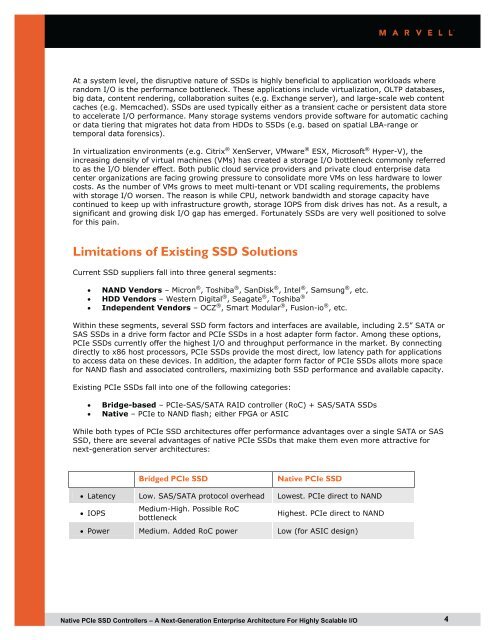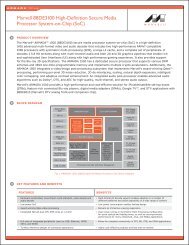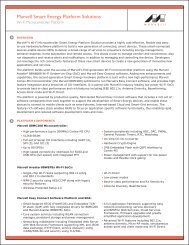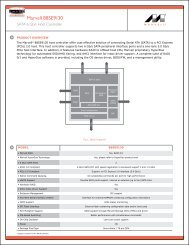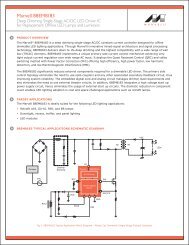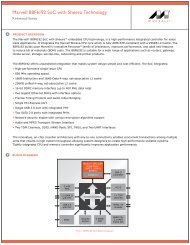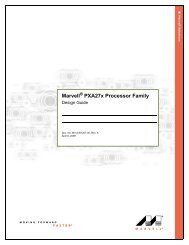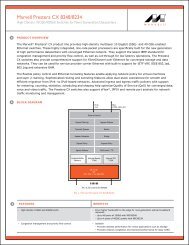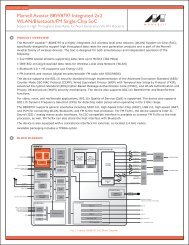Native PCIe SSD Controllers
Native PCIe SSD Controllers - Marvell
Native PCIe SSD Controllers - Marvell
You also want an ePaper? Increase the reach of your titles
YUMPU automatically turns print PDFs into web optimized ePapers that Google loves.
At a system level, the disruptive nature of <strong>SSD</strong>s is highly beneficial to application workloads where<br />
random I/O is the performance bottleneck. These applications include virtualization, OLTP databases,<br />
big data, content rendering, collaboration suites (e.g. Exchange server), and large-scale web content<br />
caches (e.g. Memcached). <strong>SSD</strong>s are used typically either as a transient cache or persistent data store<br />
to accelerate I/O performance. Many storage systems vendors provide software for automatic caching<br />
or data tiering that migrates hot data from HDDs to <strong>SSD</strong>s (e.g. based on spatial LBA-range or<br />
temporal data forensics).<br />
In virtualization environments (e.g. Citrix ® XenServer, VMware ® ESX, Microsoft ® Hyper-V), the<br />
increasing density of virtual machines (VMs) has created a storage I/O bottleneck commonly referred<br />
to as the I/O blender effect. Both public cloud service providers and private cloud enterprise data<br />
center organizations are facing growing pressure to consolidate more VMs on less hardware to lower<br />
costs. As the number of VMs grows to meet multi-tenant or VDI scaling requirements, the problems<br />
with storage I/O worsen. The reason is while CPU, network bandwidth and storage capacity have<br />
continued to keep up with infrastructure growth, storage IOPS from disk drives has not. As a result, a<br />
significant and growing disk I/O gap has emerged. Fortunately <strong>SSD</strong>s are very well positioned to solve<br />
for this pain.<br />
Limitations of Existing <strong>SSD</strong> Solutions<br />
Current <strong>SSD</strong> suppliers fall into three general segments:<br />
• NAND Vendors – Micron ® , Toshiba ® , SanDisk ® , Intel ® , Samsung ® , etc.<br />
• HDD Vendors – Western Digital ® , Seagate ® , Toshiba ®<br />
• Independent Vendors – OCZ ® , Smart Modular ® , Fusion-io ® , etc.<br />
Within these segments, several <strong>SSD</strong> form factors and interfaces are available, including 2.5” SATA or<br />
SAS <strong>SSD</strong>s in a drive form factor and <strong>PCIe</strong> <strong>SSD</strong>s in a host adapter form factor. Among these options,<br />
<strong>PCIe</strong> <strong>SSD</strong>s currently offer the highest I/O and throughput performance in the market. By connecting<br />
directly to x86 host processors, <strong>PCIe</strong> <strong>SSD</strong>s provide the most direct, low latency path for applications<br />
to access data on these devices. In addition, the adapter form factor of <strong>PCIe</strong> <strong>SSD</strong>s allots more space<br />
for NAND flash and associated controllers, maximizing both <strong>SSD</strong> performance and available capacity.<br />
Existing <strong>PCIe</strong> <strong>SSD</strong>s fall into one of the following categories:<br />
• Bridge-based – <strong>PCIe</strong>-SAS/SATA RAID controller (RoC) + SAS/SATA <strong>SSD</strong>s<br />
• <strong>Native</strong> – <strong>PCIe</strong> to NAND flash; either FPGA or ASIC<br />
While both types of <strong>PCIe</strong> <strong>SSD</strong> architectures offer performance advantages over a single SATA or SAS<br />
<strong>SSD</strong>, there are several advantages of native <strong>PCIe</strong> <strong>SSD</strong>s that make them even more attractive for<br />
next-generation server architectures:<br />
Bridged <strong>PCIe</strong> <strong>SSD</strong><br />
<strong>Native</strong> <strong>PCIe</strong> <strong>SSD</strong><br />
• Latency Low. SAS/SATA protocol overhead Lowest. <strong>PCIe</strong> direct to NAND<br />
• IOPS<br />
Medium-High. Possible RoC<br />
bottleneck<br />
Highest. <strong>PCIe</strong> direct to NAND<br />
• Power Medium. Added RoC power Low (for ASIC design)<br />
<strong>Native</strong> <strong>PCIe</strong> <strong>SSD</strong> <strong>Controllers</strong> – A Next-Generation Enterprise Architecture For Highly Scalable I/O<br />
4


